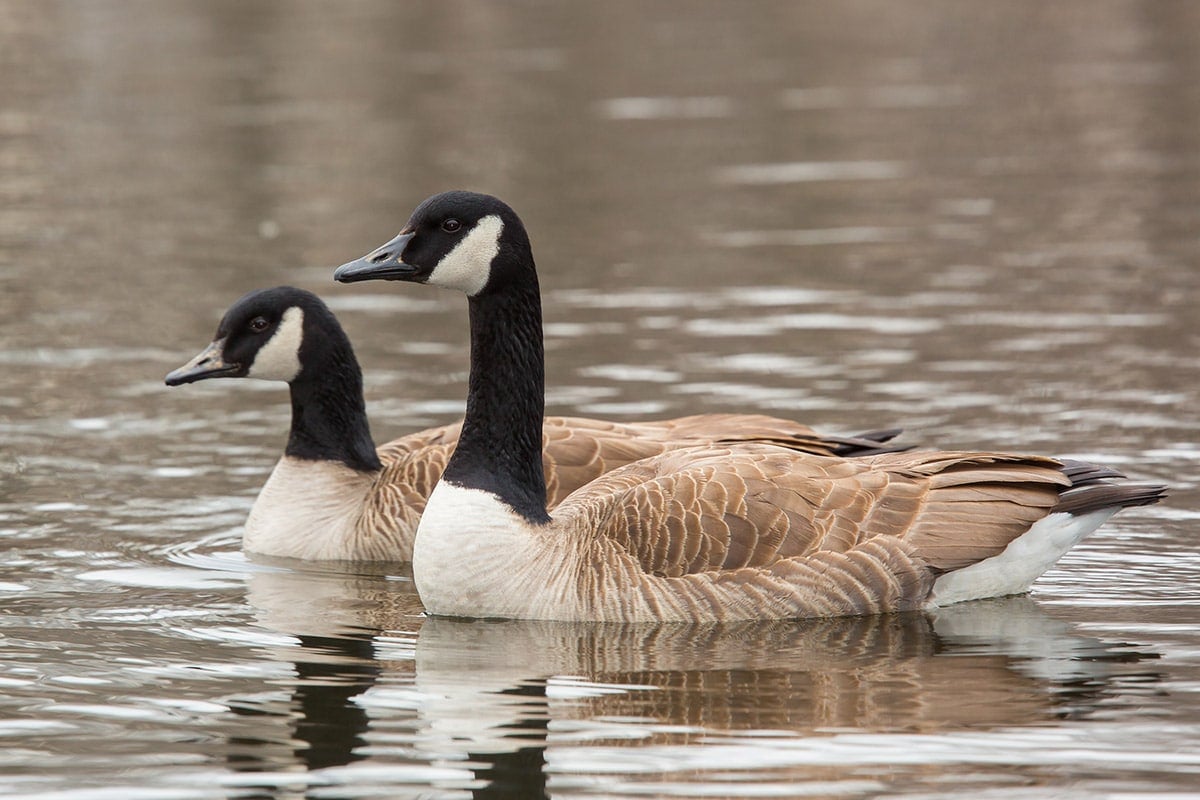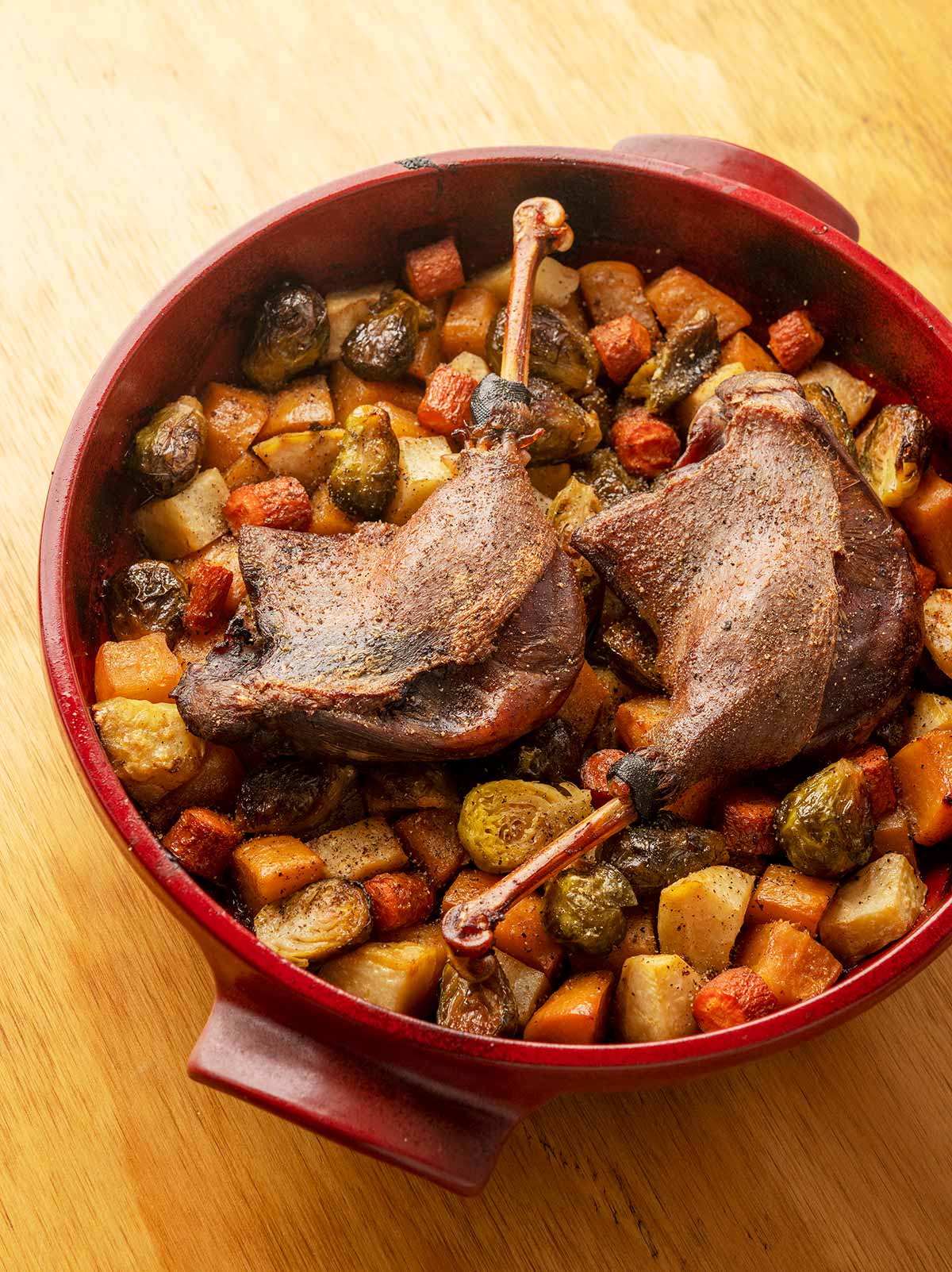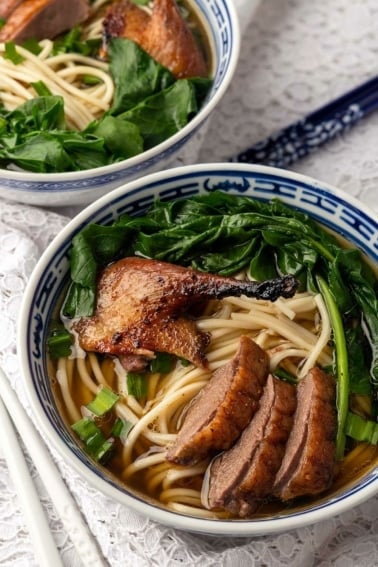As an Amazon Associate I earn from qualifying purchases.
Cooking a goose, or goose meat in general, is not so hard as people seem to think. But it does present some challenges, no matter if you are buying goose at the store, or hunting them.
Canada geese, especially, get a bad rap. We all know this goose. It’s the one that chokes our parks, wanders around our neighborhoods and leaves great cylindrical snakes o’crap all over the place. Sky carp. Flying rats, Stinking, arrogant hissing birds that frighten children.

Yeah, Canadas can be all of these things. But in the right circumstances they — and all the other species of goose — can be wonderful at the table, in many ways better even than either a domestic goose or a wild specklebelly goose, which is known to those of us who hunt them as “the ribeye of the sky.”
OK, let’s start with a rundown of species, because the goose meat you cook will be different depending on it.
First, there will be the domesticated goose. These are primarily descendants of the European graylag goose, Anser anser, who is cousin to our whitefront or specklebelly goose, Anser albifrons. Another early place of domestication, Asia, worked with the native swan goose there.
More than 3000 years of domestication has altered domesticated geese significantly. They are larger and fatter than any wild goose. Their meat will be softer and less dense than wild ones. We’ll get to cooking farmed geese in a moment.
Here in North America, we primarily hunt Canada geese, snow geese and whitefronts. Emperor geese and the Atlantic and Pacific brants also fall into this mix.
I’ve written about eating snow geese extensively here, so I will refer you to that article if that’s what you are looking for. Short version: snow geese are one of my favorite sources of skinless goose meat.
Brants are easy: Skin them on the East Coast, pluck on Pacific. It’s diet related. Pacific brant eat eelgrass, which gives them wonderful white fat that is not at all fishy. Atlantic brant eat sea lettuce, a seaweed, and their fat stinks of low tide.

Whitefronts (specklebelly geese) are universally regarded as the finest wild goose for eating. They are mostly seed and grain eaters, and are always nice tasting.
That leaves Canada geese. All sorts of geese look like Canadas, from tiny Aleutian geese no larger than a mallard, to the Giant Canadas, which can reportedly top 20 pounds. That, my friends, is one big-ass goose. Most honkers weigh around 12 pounds, more or less.
Canada geese live lives like large mallards, which is why you see them sharing the same park ponds. Both birds will eat just about anything, but geese really dig grass, and yes, grain. How a Canada tastes depends on what that bird ate before you shot it. And because they are such eclectic eaters, it matters.
This is a universal truth: The quality of goose meat hinges on the bird’s diet, farmed or wild.
Plucking or Skinning
When it comes to cleaning geese, most of you will be working with store-bought birds. And while most are already plucked and gutted, you will still want to remove the giblets (often in a little bag in the cavity) and the bog blobs of fat in the cavity.
The fat you will want to render — here is my tutorial on how to render duck fat — and the giblets are great for a variety of recipes. I have an entire selection of goose giblets recipes here.
Those two things apply to wild geese, too, but you have to get there first. Plucking geese turns lots of people off. This is understandable: Once you start talking about an animal 12 pounds or larger, everything gets harder to deal with.
The feathers on a large Canada are tough to remove, and waxing one takes two full blocks of paraffin. God help you if you try to dry-pluck one. I only pluck Canada geese when I have only a few, or when I have many, only the ones that are not shot up. It’s work, but it’s worth it.

Plucking snow geese can be difficult, and I only do it when they are fat, which is rare. I always pluck whitefront geese and Pacific brant.
Cooking Goose Meat
Once you have your geese, now what?
Let’s start with those of you who have a whole, store-bough goose. Chances are you want to roast it whole for a special occasion. My advice is to use my recipe for roast goose on Simply Recipes. It is designed for farmed birds.
If you aren’t set on cooking a whole goose, my strong advice is to break it down, wild or farmed. The reason is because you want to cook goose breast no more than to about 135°F internal temperature, but goose legs need more time, about 165°F internal temperature. That’s impossible with a whole bird.
Here’s the shortcut: Always cook breast meat like steak, and legs and wings like brisket. The way you cook a goose is the way you cook beef. In the kitchen, they are not treated like birds.

If you have straight up goose meat, which is what most hunters come home with — skinless, boneless breasts, and/or skinless legs — here are some options.
First off, know that goose meat is basically steak, from the equivalent of a really old cow. Geese can live beyond 30 years, and that’s an incredibly old bird. Its meat will be far tougher than a young goose. You never need worry about this with domesticated geese, because they are always less than a year old.
Goose meat, in my opinion, is 100 percent interchangeable with venison, and can be used in beef recipes, too. Common ways to deal with it include:
- Grinding goose meat with pork fat, bacon ends or beef fat for any ground meat dish you like, or to make homemade sausages.
- Slicing the breast meat thinly for goose jerky.
- Dicing, slicing or julienning goose breast for any Chinese stir fry that would normally use beef, like beef and broccoli.
- You can marinate goose meat like steak for fajitas.
- You can slice it lengthwise, so you have cutlets, for jagerschnitzel, goose parmesan, or goose tacos.
- Goose pastrami is a great way to eat Canada goose breasts.
If you have a fat, skin-on goose breast of any species, you can make a wonderful German smoked goose breast recipe I do when I am so lucky as to have them.

As for the legs, they are a slow cooker meat with few equals. Start here for goose leg options. Any recipe you can think of where you slow cook meat, shred it, and use it in a dish will work with goose legs. If you need a place to start, you could do worse than this barbacoa recipe.
Keep in mind that I have a whole ton of duck and goose recipes on this site, and every new season I refine old recipes and add new ones.
What’s the takeaway? For hunters, know that there are all sorts of things you can do to cook goose that you might not have thought of before; they have advantages — largely size — that let you do some things you can’t with other waterfowl.





Dry plucking is really not all of that bad if you can stand the down up your nose. When we do it, we remove the feathers first then go for the down. We once made the mistake of using the wife’s fan to suck the floating down out of the garage…big mistake, plucking the fan was worse than plucking the goose. Once the down is off we used a propane torch to make for a perfect skin.
Hank,
I can’t agree with you about hanging geese just three days. I hunt on the Eastern shore of Maryland and we kill a few geese. I hang all of my geese for a week, then I breast them out and keep them in the fridge for another 3, 4 days or a week before freezing them. I have never had a bad goose breast. I marinate them in salad dressing or sprinkle them with Montreal Steak seasoning and grill them. I try not to get much past medium rare so as if I want to reheat the leftovers in the microwave, they aren’t over cooked. I enjoy just slicing a piece of cold goose breast off and eating it cold.
Stir fried goose breast in soy or Worchester sauce is great too.
I am preparing at this minute to make a goose soup…that is why I am here. Problem is finding a goose stock. In the past, and probably today, I use Mrs. Grass soup mix with a beef stock…comes out pretty good.
Any ideas for the goose stock?
Minna: Well, my first thought is why did you hang it for 6 days? I never do that with waterfowl. Pheasants, maybe, but not geese or ducks. The gaminess and funk is almost certainly due to the long hang time. Don’t hang geese more than a day or so unless you enjoy that flavor. I do, for what it’s worth.
As for cooking, please don’t try to roast it whole. You will be disappointed. Break it down and slow cook the legs and wings and pan roasted the breast to medium-rare.
I was given my first goose last week… I grew up on a farm and know how to slaughter and hang, but I’m not sure what the goose meat should smell like when all done. (My mom hates waterfowl, I hadn’t even had duck till I was in college). We hung our Canada goose for 6 days and when we broke it down, my poor husband was retching and puking most of the way through. After breaking it down yesterday I washed and refrigerated it since I was planning on cooking it today, but it still has a funky smell to me… So I am wondering if it is just the gaminess and its normal, or I hung it too long and it needs to be tossed? Any thoughts?
Jimi: I don’t recommend cooking a goose on a rotisserie. They’re pretty big, and unless you have a very sturdy rotisserie, the weight of the goose will mess it up. Besides, goose breast is best served medium-rare, while the legs are best slow-cooked.
Awesome post. I have just gone goose hunting for the first time in 8 years. Great day came home with 4 Canada geese. One weighing in at 17 lbs. Now I must try making 4 neck sausages.
One question, Is it a good method to cook a whole Canada goose on a rotisserie? I know you can roast them and it works well.
Thanks for the great recipes
My husband has several ‘canada’ geese in the freezer and was tole that a cure will make wild goose more tender – specirfically Sure Cure. Found the product but unfortunately no instructions included. Can you tell me how to cure a wild goose breast?
The article is great timing Hank. I just went to Rochester, MN where the largest flock of Branta Canadensis Maxima (Giant Canada) is located in North America. I shot one that was close to 16 pounds. Wow…..did that goose made a thud when it hit the ground! I have 8 legs that I am going to sous vide this weekend.
For sous vide I use a crock pot hooked to a thermostat. I put the probe right into the water. Ghetto fo’ sho’, but it works!
I’ve cleaned a lot of Canada Geese and they smell from the moment you open the skin. Usually we just breast them out, rather than going through the arduous process of plucking or waxing them, though after reading this I may have to try stuffing a goose neck.
And for the record, I wouldn’t eat anything found living in Central Park. Now the pretzels and dirty water hot dogs…that’s another story.
Hi!!! I recently found your blog and I’ve gotta tell you I just LOVE IT!!! and this kind of posts are so useful, please keep them going. Btw thank’s for the sausage idea, I must try this.
Thank you! Thank you! For setting the world straight on the wrong-ness of calling them “canadian” geese. That irks me so much I can’t stand it! Unfortunately, I’ll bet that most people coming to your site (and reading your glorious writing) already know that they are “canada geese.” Wish you could reach the whole rest of the world, too.
LoL. A baseball bat? Hank, you have a morbid sense of humor.
As for Central Park geese, I once heard (it could be urban legend) that one mayor of New York proposed a recipe pamphlet to help New Yorkers help themselves in ridding the city of its pigeon and rat infestations. I suppose if city-fed rat (both flying and crawling) could be on a menu, a goose can’t be too far behind.
I was curious though, is it safe to eat aged meat rare, even if you aged in a semi-cold environment? Isn’t there a concern from bacterial buildup, especially if you age for 3 days or longer? I read your post on hanging pheasants, but I don’t believe you mentioned eating anything rare.
Lastly, I understood your explaination of the name, but it’s going to be hard for me not to call them Canadian goose/geese. It’s like saying Germany Sheperd or Tasmania Devil (Netherland apple pie anyone?). You just want to turn it into an adjective so badly. Hell, I’ll probably still do it, improper though it may be. I’ll just try to refrain on your site. 🙂
E. Nassar: I have the sous vide supreme, which is my new favorite toy. The Polyscience one is better but twice as expensive.
Karen: I thought I heard something coming from inside the oven when I was cooking that sausage… 😉
Heather: I’ll have to make some for you next time I come up to Portland!
Got something against Canadians – geese or otherwise? Although it’s a stretch, we don’t go calling Californians or Alaskans or New Yorkers California Humans or Alaska Humans or New York Humans… hehehehe
Look at that fancy light box light! That time of year again, innit.
I’m gurgling my own spit over the neck and mortadella. And thank you for the bitch-slap on “Canadian” goose. Drives me crazy, too.
The breasts look wonderful with the pears, but that neck sausage and mortadella are calling my name!
Hank! What a beautiful looking dish AND Sous Vide! You cannot just gloss over that part. What did you buy? Sous Vide Supreme? Or the PolyScience one?
WOW! Fantastic post! I’m excited about some of these recipes. We get the Giant Canadas down here in KY and I routinely shoot birds near the 20 lb mark. Put a lot of them in the freezer last year and plan to do more of the same this year. These will come in handy.
Brilliant idea! I can’t wait to try the neck sausage idea. That is just great. Thanks.